Marktech Optoelectronics
3 Northway Lane North
Latham, NY 12110
Fax: +1-785-4725
Email: info@marktechopto.com
The broadest line of both silicon and InGaAs detectors commercially available.
Indium Gallium Arsenide (InGaAs) PIN photodiodes are made using InGaAs/InP technology.
Cutting-edge silicon photodetectors that excel in precise detection of light ranging in wavelength from 250nm to 1100nm
Monolithic “quads” or quadrant photodiodes (QPDs) are 2 X 2 photodiode arrays with four planar diffused photodiode elements or segments.
Marktech offers a broad line of silicon photo Transistors in a variety of package types ranging from miniature metal can to ceramic packages.
Our High-Reliability Photoreflectors are sensors that contain both the LED emitter and photodetector functions within a single package.
Marktech Si APD’s offer low-level light and short pulse detections of wavelengths between 400 nm and 1100 nm.
UV detectors are offered in a variety of TO metal-can type packages from TO-18 to TO-39 with special UV glass lens to insure optimum lifetime and the least amount of material degradation
With the ability to detect light in the UV, visible, and infrared spectrums, photo detectors, photo transistors, and photodiodes are being used in increasingly more applications.
Marktech offers the broadest range of emitters commercially available ranging from 235nm to 4300nm across the UV, visible, NIR, SWIR, and MWIR spectral ranges.
Marktech offers the broadest range of UV LEDs commercially available ranging from 235nm to 400nm including UVA, UVB, UVC, and deep UVC LEDs.
Our advanced line of visible LED products is engineered to deliver high-quality, energy-efficient lighting solutions across various applications from 400nm to 700nm..
Our NIR LED wavelength range is typically from 700nm to 1000nm, extending into wavelengths invisible to the human eye but crucial for numerous technological and scientific applications.
Our standard product offering includes wavelengths from 1020nm to 3000nm and operating currents ranging from 20mA to 350mA for high-power applications.
Our Point Source LEDs are specifically engineered for optical encoders, edge sensors, and other critical applications that demand highly focused light with minimal dispersion.
Multi-LED chips in a single package, our multiple wavelength LEDs are engineered to address a myriad of applications across the UV, visible, NIR, SWIR, and MWIR spectral ranges
Designed to produce a highly defined red dot or reticle, facilitating accurate aiming without revealing the location to the target.
Ideally suited for applications including edge sensing, line sensing, coin bill validation, and bar code reading
Our panels are crafted to deliver uniform, vibrant illumination across a wide range of applications, from consumer electronics to industrial displays.
Crafted with the latest LED technology, these rings provide adjustable illumination to meet specific needs, ensuring optimal visibility and enhancing the quality of your projects.
As a proud CREE LED Solution Provider for over a decade, Marktech offers comprehensive engineering support, including design, binning, and material selection, alongside custom packaging options for specialized applications.
CREE LED through-hole emitters, designed for high-temperature and moisture environments with UV-resistant optical-grade epoxy, offer a range of colors for versatile applications in signage and lighting.
CREE High Brightness (HB) SMD LEDs are the brightest, most reliable architectural, video, signage, scoreboard, roadway, and specialty LEDs available today.
CREE LED’s P4 series represents a leap in LED design, combining efficiency with aesthetic versatility to meet the demands of modern lighting applications.
Marktech’s CREE LED XLamp® offerings on aluminum core starboards simplify LED integration for designers, providing a range of colors and angles on compact boards for easy testing and implementation in varied lighting applications.
Marktech Optoelectronics introduces its new product line of CREE LED die, including the EZ1350 Series Die, packaged in TO-cans (TO-18 and TO-39 outlines) designed for precision and reliability in demanding applications with protection against environmental factors like moisture and dust.
Marktech Optoelectronics combines over 40 years of expertise in optoelectronics with a focus on customized engineering solutions, addressing specific customer needs and applications.
Custom photodiode detectors are designed to meet unique customer requirements, offering specialized performance features and cost savings through optimizations such as integrated filters, photodiode arrays, and hybridization.
Through our vertically integrated manufacturing facilities in California and Japan, we offer custom LED solutions, including packaging and optoelectrical categorization, enhancing product design and market readiness.
Multiple LED dies combined in a single package are engineered to address various applications across the UV, visible, NIR, SWIR, and MWIR spectral ranges.
To succeed, you need the exact optoelectronic package custom-designed and manufactured for your application, including hermetic metal SMD, TO-can, plastic SMD, and molded through-hole packaging.
Made-to-order semiconductor chips (die) and wafers are designed and fabricated to fit your needs. Standard dies are available in specific wavelengths for high-volume production applications.
Bare and encapsulated LEDs, photodiodes, and other components are assembled on FR4, metal-cored, and flexible circuit boards, ready for production.
Learn about the latest trends, devices, and potential applications.
The latest news and announcements from Marktech Optoelectronics.
Detailed information about common uses for Marktech Optoelectronics devices.
In depth discussions on LEDs, Detectors and the science behind them.
Become familiar with common terminology and concepts for LED Devices.
List of common concepts and definitions for Photodiodes.
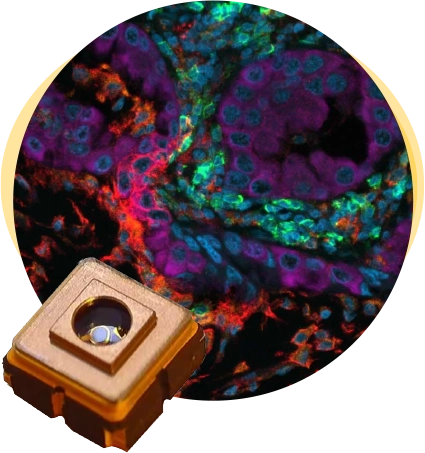
Instead of using standardized–but perhaps non-optimized–parts, Marktech allows advantageous custom product variations to enhance your product design needs. Marktech Optoelectronics has solved many customers’ detector and LED design, assembly, and manufacturing challenges. Marktech’s size and market focus allows it to offer customized variations of products unavailable from typical optoelectronic suppliers.
Resources are provided for component selection, packaging options, testing, and expert advice, providing the designer with insights concerning custom variations that can be leveraged to optimize electrical, optical, mechanical, and thermal characteristics–without significant volume commitments.
Total cost benefit, a crucial concept in realizing the benefits of custom optoelectronics, involves evaluating financial and non-financial gains (intangible benefits such as performance and design simplification) against the total costs, including potential risks and expenditures. This broader evaluation helps stakeholders make well-informed decisions by considering all possible direct, indirect, tangible, and intangible benefits and costs.
There are several strategies to optimize the cost-effectiveness and performance of photodiodes and LEDs in OEM designs:
Engineers should choose components that are specifically tailored to their application requirements, which include sensitivity, wavelength range, reliability, and cost-effectiveness. Custom solutions, such as combining two photodiodes into one package or developing detectors with lower active areas, can reduce total costs and simplify designs.
For example, Marktech’s UVC LEDs target specific bacteria like cryptosporidium more efficiently than broad-spectrum mercury vapor lamps, enhancing energy efficiency and extending battery life. This approach underscores the importance of selecting the correct wavelength for the application to improve performance and cost benefits.
Bespoke optoelectronic components can provide unique characteristics that are not easily duplicated, offering a competitive edge. This customization can also eliminate the need for additional components like optical filters or amplifiers, further reducing system costs and improving product performance.
Photodiodes and LEDs are widely used in various applications, including sensing, medical diagnostic devices, and communication systems. Combining multiple LEDs and photodiodes with the precise wavelength and power output required for specific design in the same package can provide unique performance combined with lower component costs. Engineers can optimize performance while minimizing costs by tailoring these components to OEM design needs. This approach also adds value through unique features that are difficult for competitors to replicate, underlining the strategic importance of customizing optoelectronic components in achieving superior design outcomes.
In summary, OEM services for the customization of photodiodes and LEDs are potent tools for optimizing the cost and performance of OEM designs. Engineers can create efficient and cost-effective systems by selecting the appropriate components and tailoring them to the application’s specific needs. With careful consideration of the performance and cost trade-offs, photodiodes and LEDs can be used to create systems that maximize the total cost benefit for OEM designs. They also provide unique features that are difficult for competitors to duplicate.
You can read more about optimizing total cost benefits with Customization here: “Maximizing Total Cost Benefit with Tailored Photodiodes and LEDs for OEM Designs.”
Marktech has the design and test expertise to get your product to market faster, working with you from prototype testing to high-volume production.
What you can expect from working with Marktech:

Initially, our staff of experienced engineers will gain an understanding of your application and the environment in which it will be used.

Next, using computer-aided design (CAD), specialized software, and engineering tools, we operate within the parameters of your primary concept and specification documents to design and develop a product that meets your requirements.
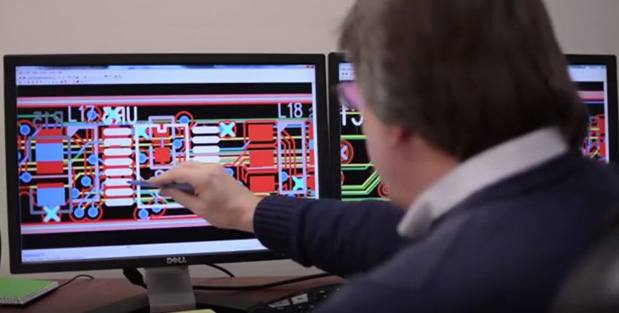
Once a prototype of your product is created, testing can begin in our onsite components lab. A complete onsite components lab with measurement capability to validate wavelength, angles, simulation of specific conditions, and full optical and electrical parametric characterization supports testing. Optical measurements can be obtained either “Photometrically” or “Radiometrically” as described below. Marktech’s application support includes electrical parameter tests, environmental test screening, and reliability testing for your specific needs.
Photometry is simply the measurement of light in the visible spectrum (approximately 380nm-770nm), which is light seen by the naked eye of an average human observer. There are many different types of photometric units, such as nits (cd/m2), lux (lumen/m2), footcandles (lumen/ft2), stilb (cd/cm2), etc. These are based on two basic photometric standards: the LUMEN and the CANDELA.
The Candela is the unit of luminous intensity, defined as the amount of radiant flux (total luminous power emitted from a source and expressed as lumens) per unit solid angle in a given direction. The Lumen can be defined as the radiant flux emitted per unit solid angle from a uniform point source whose luminous intensity is 1 candela. (1 candela = 1 lumen/steradian) It is also essential to understand the definition of steradian, which is the solid angle (cone) at the center of a sphere of radius “r” that subtends an area “r2” on the surface of the sphere. (See Figure 1) The surface area of a sphere is 4Ï€ r2; therefore, a sphere has 4Ï€ steradians.
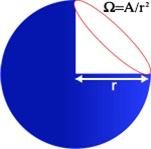
Figure 1
Radiometry refers to total radiation or measuring all light in the visible, infrared, or ultraviolet spectrum. The basic unit of radiometric optical power (Radiant Power) is the watt (W). The watt is an absolute unit because it is independent of wavelength. One watt of infrared light is as powerful as one watt of visible light. Other radiometric terms that are commonly measured are radiant intensity (Watts/Steradian), Irradiance (W/m2), and Radiance (W/m2 sr). Using an integrating sphere is the primary method for measuring total radiant power/luminous flux. (See Figure 2 – 5)
The integrating sphere measures light emitted from the LED in all directions. Generally, these measurements are independent of viewing angle and not subject to angular measurement inaccuracies seen when testing photometrically. However, errors are still possible. Sphere diameters of approximately 3 and 6 inches are widely used. If accuracy is critical, the more significant diameter types are preferred due to the favorable ratio of the sphere area to the size of the LED and ports. However, this also results in a loss of intensity. A significant source of measurement error has been where to position the LED inside the integrating sphere. The latest specification adopted by the CIE, Publication 127, states that the entire package of the LED should be inside the sphere, which is called a two-luminous flux measurement.
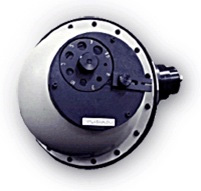
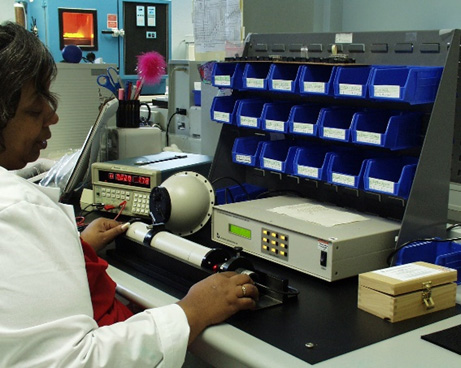

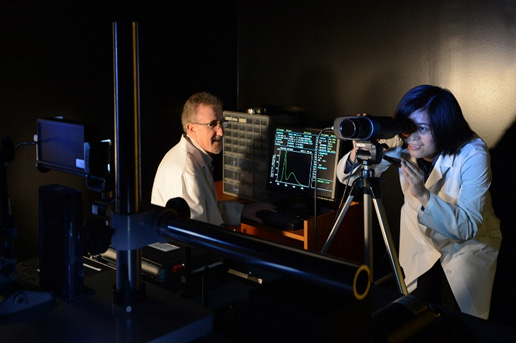
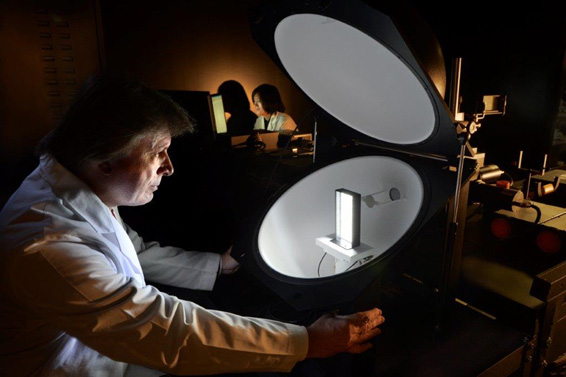
Many factors affect the reliability and lifetime of optoelectronic devices and assemblies. Marktech ensures that all products designed, prototyped, and manufactured undergo rigorous testing and screening to ensure optimal performance and life. Some of these conditions are outlined below.
Calculating information such as the longevity characteristics (at high temperatures, normal temperatures, and low temperatures) of discrete LEDs and photodiodes in an environment in which the equipment will be used and testing those calculations by testing the equipment’s operation may be useful.
Depending on the material used in an LED or photodiode, operating it under high-humidity, high-temperature conditions can dramatically reduce its lifetime. Check their longevity characteristics when optoelectronic devices are used under high-humidity, high-temperature conditions.
Because lattice defects increase with use, the luminous intensity of LEDs gradually declines. The accumulation speed of lattice defects depends on the magnitude of the forward current.
When using LEDs and photodiodes under conditions where factors such as vibration, shock, gas, or ultraviolet affect the wire bond leads or die-bonding resin, Marktech recommends testing the optoelectronic devices separately for each potential affecting factor.
Temperature cycle testing is typically performed on the LED lamp structure at the upper and lower-limit storage temperatures.a
The following examples show how simulation can be used to obtain longevity information. For simplicity, the characteristics of a hypothetical LED lamp are used. Example (a): Simulate the longevity of an LED lamp incorporated in control equipment installed in a room in which high-temperature equipment is operating.
High-temperature equipment operates for 1,080 hours a year (three hours a day x 360 days) with a forward current of 20 mA.
LED lamp ambient temperature is 60°C, 60 days per year, humidity=”90%”
LED lamp ambient temperature is 40°C, 90 days per year, humidity=”90%”
LED lamp ambient temperature is 25°C, 210 days per year, humidity=”90%”
LED lamp longevity characteristics: Figure 6 shows the longevity characteristics of LED lamps.
REL Luminosity vs. Time
Figure 6 – Simulation longevity characteristics
Calculating the LED lamp operating time per year by ambient temperature.
Condition 1 operating time: 3 hours x 60 days = 180 hours
Condition 2 operating time: 3 hours x 90 days = 270 hours
Condition 3 operating time: 3 hours x 210 days = 630 hours
Figure 7 shows the results. In the example, the longevity characteristics are simulated by the approximate equation exp(-8 t), with 8 changing each time. Where the curve time constants for the characteristics in Figure 6 are 81, 82, 83, and luminosity reduction rate = exp (-8nt), the calculation is made by assigning 8 to each operating time.
Note: It is impossible to represent all the different longevity characteristics by a single approximate equation. It would be risky to extrapolate the characteristics over ten or 20 years based on the above examples and expect the results to be accurate, even if the daily operating time was short. REL Luminosity Residue vs Time 1
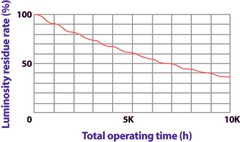
Figure 7 – Simulation example
Recent improvements have reduced the tendency for LED lamp luminosity to decline with use. The results of long-term studies of longevity characteristics now show that the luminosity need not always attenuate. The decrease in luminosity during use has been
evaluated using a Wiebel distribution function. Sometimes, even after thousands of hours of longevity testing, the M-value does not change thousands of hours (see Figure 8).
REL Luminosity Residue vs Time 2
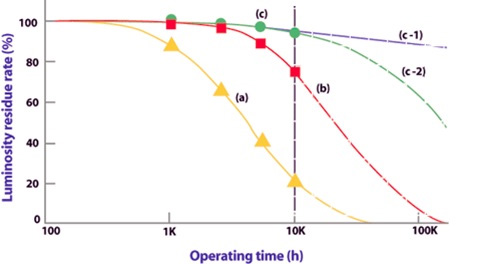
Figure 8 – Predictions from longevity test results (a), (b), (c)
With the tendency for luminosity to deteriorate already confirmed by the results of long-term longevity tests in Figure 8(a) and (b), longevity can now be predicted relatively easily. However, no deterioration is seen in Figure 8 (c), even after 10,000 hours of use. It is not possible to decide whether deterioration proceeds in the (c-1) direction or the (c-2) direction. In some cases, the deterioration in the M-value is significant after a certain point, as in (c-2).
The absence of luminosity reduction during longevity tests does not mean that the LED lamp will not deteriorate at some point. If necessary, longevity testing under accelerated conditions is performed to predict the longevity characteristics based on the actual conditions of use when determining where a piece of equipment incorporating an LED is to be used.
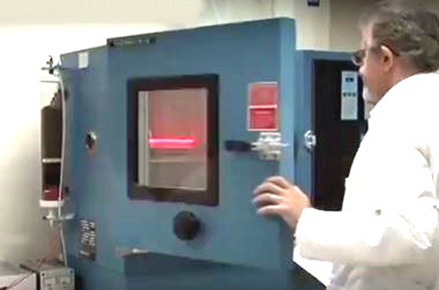
Tenney (Thermal Product Solutions) Temperature/ Humidity Test Chambers are typically used for 85C/ 85% Relative Humidity rigorous environmental component life testing. Electrical bias testing is optionally included.
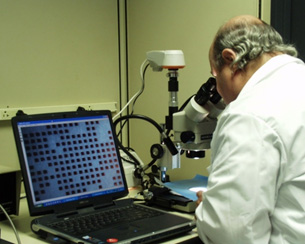
By utilizing Marktech’s value-added engineering services, you will get a custom component or assembly that meets your unique specifications. We provide our customers extensive testing and evaluation capabilities, ensuring your product functions exactly as expected.
Marktech’s testing and evaluation services include:
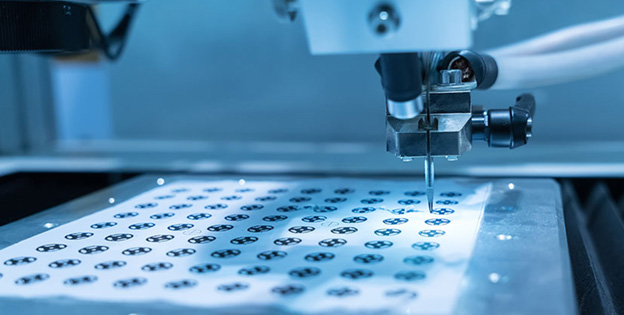
Marktech offers unique lighting solutions when it comes to machine vision lighting. To begin with, we design our own printed circuit boards and specify the material composition since this is critical for proper die attachment and wire bonding of the bare die. We also can sort +/- 1 nanometer on the die or luminosity and power output ratios of less than 2 to 1. Of great interest to our customer base is the fact that we can guarantee uniformity of light across large surface areas. Marktech can assist you in making the transition from through hole to chip on board. From the initial concept to the final product, which includes the housing, Marktech can help relieve the stress of achieving maximum lighting for your machine vision application.
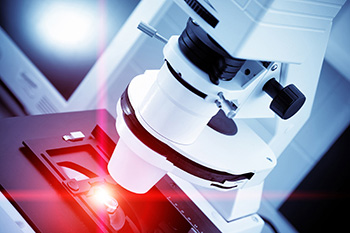
Proprietary advanced inspection equipment
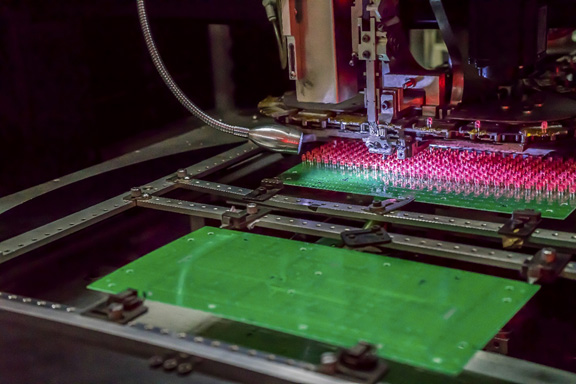
High-speed LED insertion.
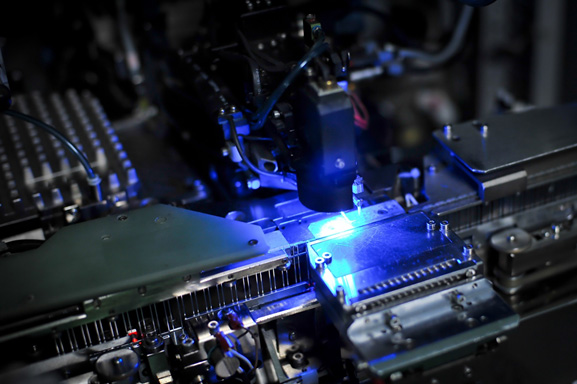
Machine vision inspection system
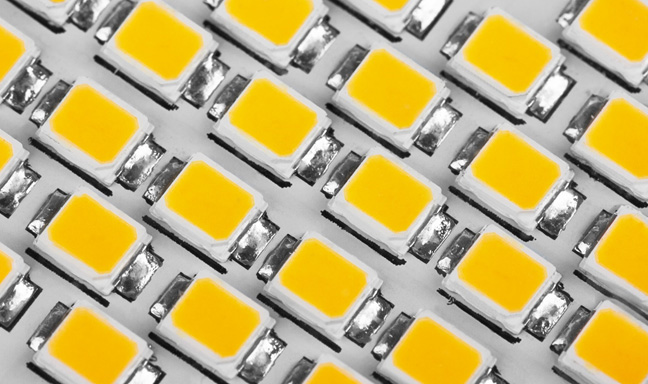
White LED strips and panels
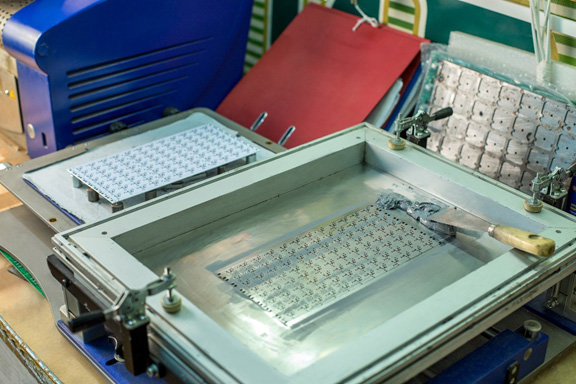
StarBoard solder paste process
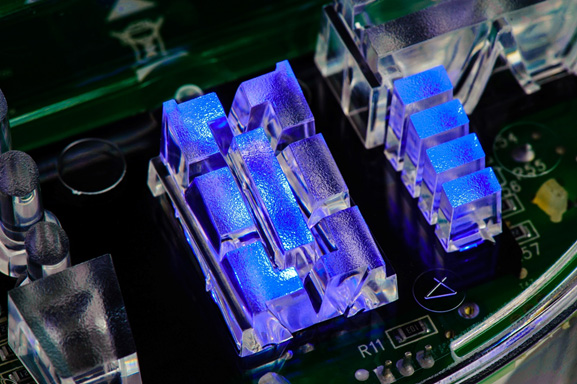
Customized optical package design
Customer service is a top priority at Marktech. So, even after delivery, our team will stay in touch to make certain that your products are performing as expected.
Find something you were looking for. Get a free, no-obligation quote today.
Let us help select the perfect parts and services to make your application come to life.
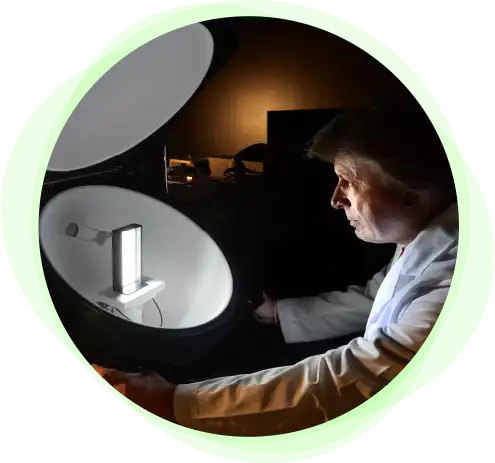
Do you need a small number of LEDs for your proof of concept? Or, are you looking to purchase a run for your prototypes? Visit our online stores at Digi-Key Electronics and Mouser Electronics today. In Japan, our products are now available through Rikei Corporation. In Israel, our products are now available through Militram. In Canada, our products are now available through ARL Group.
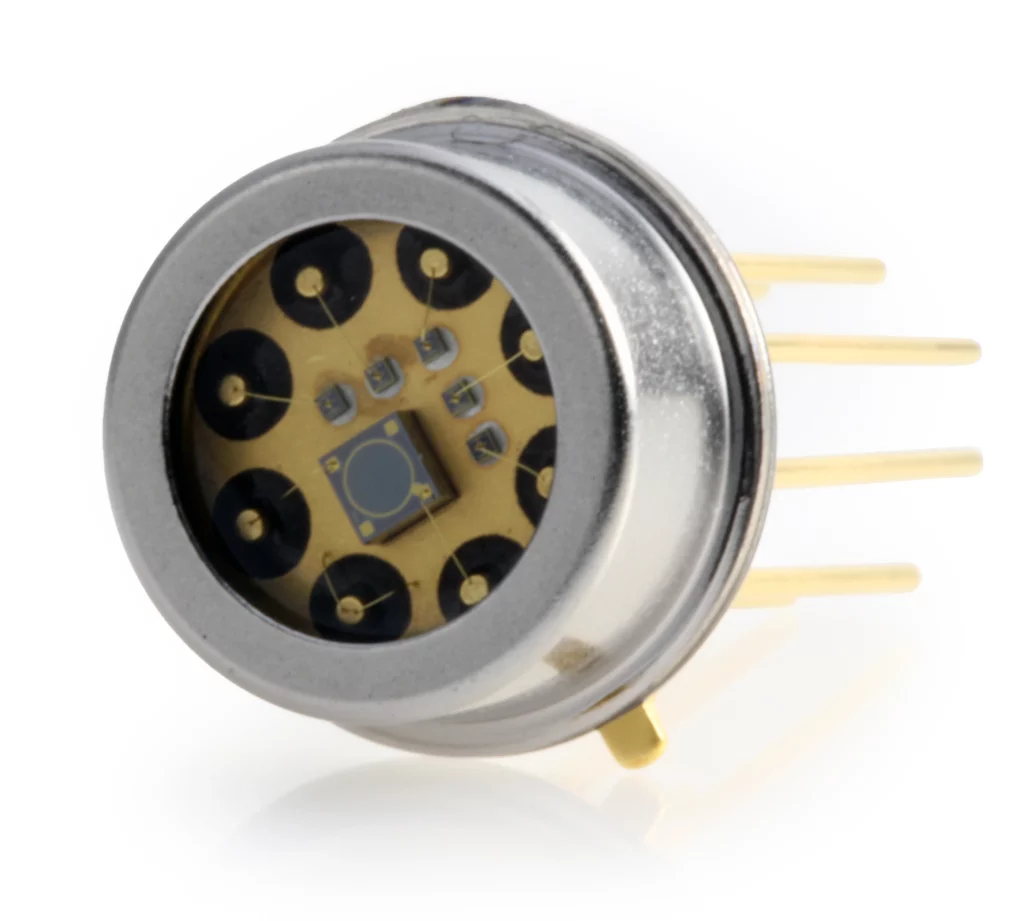

As our industry constantly changes and evolves, Marktech has been there since the start. Stay on top of new and upcoming technology trends, industry news and new product offerings.
Marktech Optoelectronics
3 Northway Lane North
Latham, NY 12110
Fax: +1-785-4725
Email: info@marktechopto.com